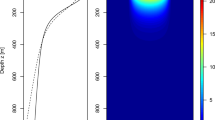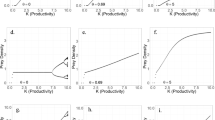Abstract
Diel vertical migration is a behavioral antipredator defense that is shaped by a trade-off between higher predation risk in surface waters and reduced growth in deeper waters. The strength of migration of zooplankton increases with a rise in the abundance of predators and their exudates (kairomone). Recent studies span multiple trophic levels, which lead to the concept of coupled vertical migration. The migrations that occur at one trophic level can affect the vertical migration of the next lower trophic level, and so on, throughout the food chain. This is called cascading migration. In this paper, we introduce cascading migration in a well-known model (Hastings and Powell, Ecology 73:896–903, 1991). We represent the dynamics of the system as proposed by Hastings and Powell as a phytoplankton–zooplankton–fish (prey–middle predator–top predator) model where fish affect the migrations of zooplankton, which in turn affect the migrations of motile phytoplankton. The system under cascading migration enhances system stability and population coexistence. It is also observed that for a higher rate of cascading migration, the system shows chaotic behavior. We conclude that the observations of Hastings and Powell remain true if the cascading migration rate is high enough.





Similar content being viewed by others
References
Williamson, C.E., Fischer, J.M., Bollens, S.M., Overholt, E.P., Breckenridge, J.K.: Towards a more comprehensive theory of zooplankton diel vertical migration: integrating ultraviolet radiation and water transparency into the biotic paradigm. Limnol. Oceanogr. 56, 1603–1623(2011)
Cohen, J.H., Forward, R.B.: Zooplankton diel vertical migration—a review of proximate control. Oceanogr. Mar. Biol. Annu Rev. 47, 77–109(2009)
Ringelberg, J.: Diel Vertical Migration in Lakes and Oceans: Causal Explanations and Adaptive Significances. Springer, Berlin (2010)
Bollens S.M., Rollwagen-Bollens, G.C., Quenette, J.A., Bochdansky, A.B.: Cascading migrations and implications for vertical fluxes in pelagic ecosystems. J. Plankton Res. 33, 349–355 (2011)
De Meester, L., Dawidowicz, P., Van Gool, E., Loose, C.J. Tollrian, R., Harvell, C.D. (eds.): Ecology and evolution of predator induced behavior of zooplankton: depth selection behavior and diel vertical migration. The Ecology and Evolution of Inducible Defenses, pp. 160–176. Princeton University Press, Princeton (1999)
Dodson, S.I.: The ecological role of chemical stimuli for the zooplankton: predator-avoidance behavior in Daphnia. Limnol. Oceanogr. 33, 1431–1439 (1988)
Gliwicz, M.Z.: Predation and the evolution of vertical migration in zooplankton. Nature 320, 746–748 (1986)
Lampert, W.: The adaptive significance of diel vertical migration of zooplankton. Funct. Ecol. 3, 21–27 (1989)
Lampert, W.: Ultimate causes of diel vertical migration of zooplankton: new evidence for the predator-avoidance hypothesis. Arch. Hydrol. 39, 79–88 (1993)
Lass, S., Spaak, P.: Chemically induced anti-predator defences in plankton: a review. Hydrobiologia 491, 221–239 (2003)
Loose, C.J., Dawidowicz, P.: Trade-offs in diel vertical migration by zooplankton: The costs of predator avoidance. Ecology 75(8), 2255–2263 (1994)
Neill, W.E.: Induced vertical migration in copepods as a defence against invertebrate predation. Nature 345, 524–526 (1990)
Stich, H.B., Lampert, W.: Predator evasion as an explanation of diurnal vertical migration by zooplankton. Nature 293, 396–398 (1981)
Bollens, S.M., Frost, B.W., Cordell, J.R.: Chemical, mechanical, and visual cues in the vertical migration behavior of the marine planktonic copepod Acartia hudsonica. J. Plankton Res. 16, 555–564 (1994)
Cayelan, C.C., Moana, P.C., Sarah, M.C., Angela, M.E., William, W.F., David, C., Nelson, G.H. Jr.: Predator-dependent diel migration by Halocaridina rubra shrimp (Malacostraca: Atyidae) in Hawaiian anchialine pools. Aquat. Ecol. 45, 35–41 (2011)
Bollens, S.M., Frost, B.W.: Predator-induced diel vertical migration in a planktonic copepod. J. Plankton Res. 11, 1047–1065 (1989)
Bollens, S.M., Frost, B.W.: Zooplanktivorous fish and variable diel vertical migration in the marine planktonic copepod Calanus pacificus. Limnol. Oceanogr. 34, 1072–1083 (1989)
Hays, G.C.: A review of the adaptive significance and ecosystem consequences of zooplankton diel vertical migrations. Hydrobiologia 503, 163–170 (2003)
Eppley, R.W., Holm-Harisen, O., Strickland, J.D.H.: Some observations of the vertical migration of marine dinoflagellates. J. Phycol. 4, 333–340 (1968)
Blasco, D.: Observations on the diel migration of marine dinoflagellates off the Baja California coast. Mar. Biol. 46, 41–47 (1978)
Kamykowski, D., Milligan, E.J., Reed, R.E.: Relationships between geotaxis/phototaxis and diel vertical migration in autotrophic dinoflagellates. J. Plankton Res. 20, 1781–1796 (1998)
Park, J.G., Jeong, M.K., Lee, J.A. et al.: Diurnal vertical migration of a harmful dinoflagellate, Cochlodinium polykrikoides (Dinophyceae), during a red tide in coastal waters of Namhae Island, Korea. Phycologia 40, 292–297 (2001)
Schofield, O., Kerfoot, J., Mahoney, K.: Vertical migration of the toxic dinoflagellate Karenia brevis and the impact on ocean optical properties. J. Geophys. Res. Oceans 111, C06009 (2006). doi:10.1029/2005JC003115
Cullen, J.J., Horrigan, S.G.: Effects of nitrate on the diurnal vertical migration, carbon to nitrogen ratio, and the photosynthetic capacity of the dinoflagellate Gymnodinium splendens. Mar. Biol. 62, 81–89 (1981)
Doblin, M.A., Thompson, P.A., Revill, A.T., Butler, E.C.V., Blackburn, S.I., Hallengraeff, G.M.: Vertical migration of the toxic dinoflagellate Gymnodinium catenatum under different concentrations of nutrients and humic substances in culture. Harmful Algae 5, 665–677 (2006)
Erga, S.R., Dybwad, M., Frette, Ø., Lotsberg, J.K., Aursland, K.: New aspects of migratory behavior of phytoplankton in stratified waters: effects of halocline strength and light on Tetraselmis sp. (Prasinophyceae) in an artificial water column. Limnol. Oceanogr. 48, 1202–1213 (2003)
Heaney, S.I., Furnass, T.I.: Laboratory models of diel vertical migration in the dinoflagellate Ceratium hirundinella. Freshwater Biol. 10, 163–170 (1980)
Jephson, T., Carlsson, P.: Species and stratification dependent diel vertical migration behaviour of three dinoflagellate species in a laboratory study. J. Plankton Res. 31, 1353–1362 (2009)
MacIntyre, J.G., Cullen, J.J., Cembella, A.D.: Vertical migration, nutrition and toxicity in the dinoflagellate Alexandrium tamarense. Mar. Ecol. Prog. Ser. 148, 201–216 (1997)
Schaeffer, B.A., Kamykowski, D., McKay, L.: Lipid class, carotenoid, and toxin dynamics of Karenia brevis (Dinophyceae) during diel vertical migration. J. Phycol. 45, 154–163 (2009)
Bollens, S.M., Quenette, J., Rollwagen-Bollens, G.C.: Predator-enhanced diel vertical migration in a planktonic dinoflagellate. Mar. Ecol. Prog. Ser. 447, 49–54 (2012). doi:10.3354/meps09467
Hays G.C., Farquhar, M.R., Luschi, P., Teo, S.L.H., Thys, T.M.: Vertical niche overlap by two ocean giants with similar diets: oceanic sunfish and leatherback turtles. J. Exp. Mar. Biol. Ecol. 370, 134–143 (2009)
Sims, D.W., Southall, E.J., Tarling, G.A.: Habitat-specific normal and reverse diel vertical migration in the plankton-feeding basking shark. J. Anim. Ecol. 74, 755–761 (2005)
Sims, D.W., Queiroz, N., Doyle, T.K.: Satellite tracking of the world’s largest bony fish, the ocean sunfish (Mola mola L.) in the North East Atlantic. J. Exp. Mar. Biol. Ecol. 370, 127–133 (2009)
Hastings, A., Powell, T.: Chaos in a three-species food chain. Ecology 73, 896–903 (1991)
Ruxton, G.D.: Low levels of immigration between chaotic populations can reduce system extinctions by inducing asynchronous cycles. Proc. R. Soc. Lond. Ser. B 256, 189–193 (1994)
Ruxton, G.D.: Chaos in a three-species food chain with a lower bound on the bottom population. Ecology 77(1), 317–319 (1996)
Eisenberg, J.N., Maszle, D.R.: The structural stability of a three species food chain model. J. Theor. Biol. 176, 501–510 (1995)
McCann, K., Hastings, A.: Re-evaluating the omnivory-stability relationship in food webs. Proc. R. Soc. Lond. B 264, 1249–1254 (1997)
Xu, C., Li, Z.: Influence of intraspecific density dependence on a three-species food chain with and without external stochastic disturbances. Ecol. Model. 155, 71–83 (2002)
Chattopadhyay, J., Sarkar, R.R.: Chaos to order: preliminary experiments with a population dynamics models of three trophic levels. Ecol. Model. 163, 45–50 (2003)
Maionchi, D.O., dos Reis, S.F., de Aguiar M.A.M.: Chaos and pattern formation in a spatial tritrophic food chain. Ecol. Model. 191, 291–303 (2005)
Bandyopadhyay, M., Chatterjee, S., Chakraborty, S., Chattopadhyay J.: Density dependent predator death prevalence chaos in a tri-trophic food chain model. Nonlinear Anal. Model. Control 13, 305–324 (2008)
Das, K.P., Chatterjee, S., Chattopadhyay, J.: Disease in prey population and body size of intermediate predator reduce the prevalence of chaos-conclusion drawn from Hastings–Powell model. Ecol. Complex. 6, 363–374 (2009)
Chowdhury, T., Chakraborty, S., Chattopadhyay, J.: Migratory effect of middle predator in a tri-trophic food chain model. Math. Methods Appl. Sci. 33, 1699–1711 (2010)
Auger, P., Benoit, E.: A prey–predator model in a multi-patch environment with different time scales. J. Biol. Syst. 1(2), 187–197 (1993)
Auger, P., Poggiale, J.C.: Emergence of population growth models: fast migration and slow growth. J. Theor. Biol. 182, 99–108 (1996)
Auger, P., Bravo de la Parra, R.: Methods of aggregation of variables in population dynamics. C. R. Acad. Sci. Paris, Sciences de la vie 323, 665–674 (2000)
Auger, P., Charles, S., Viala, M., Poggiale, J.C.: Aggregation and emergence in ecological modelling: integration of the ecological levels. Ecol. Model. 127, 11–20 (2000)
Michalski, J., Poggiale, J.C., Arditi, R., Auger, P.: Macroscopic dynamic effects of migrations in patchy predator–prey systems. J. Theor. Biol. 185, 459–474 (1997)
Hays, G.C., Doyle, T.K., Houghton, J.R., Lilley, M.K.S., Metcalfe, J.D., Righton, D.: Diving behaviour of jellyfish equipped with electronic tags. J. Plankton Res. 30, 325–331 (2008)
Birkhoff, G., Rota, G.C.: Ordinary Differential Equations. Ginn, Boston (1982)
Acknowledgements
The authors are grateful to the reviewers for their useful comments on the previous version of the paper.
Author information
Authors and Affiliations
Corresponding author
Additional information
The research work is supported by the Council of Scientific and Industrial Research (CSIR), Human Resource Development Group, New Delhi.
Appendix
Appendix
1.1 Appendix A: Proof of Theorem 1
Let us define a function
The time derivative of Eq. (9) along with the solution of (8) is
where μ ≤ min{d 1,d 2}.
Applying the theorem of differential inequality [52], we obtain \(0 \leq W(x,y,z) \leq {L}/{\mu(1-e^{-\mu t})}+W(x_0,y_0,z_0)e^{-\mu t}\), which implies that 0 ≤ W ≤ L/μ as t → ∞. Hence, all the solutions of (8), that initiate in \(R^3_+-\{0\},\) are confined in the region \(B=\{(x,y,z)\in R^3_+: W=L/\mu+\epsilon \}\).
1.2 Appendix B: Proof of Theorem 2
For m = m *, we can write the characteristic equation
as
which has three roots \(\lambda_1=i\sqrt{\Sigma_2}\), \(\lambda_2=-i\sqrt{\Sigma_2}\) and λ 3 = − Σ1.
For all m, the roots are in general of the form
Now, we shall verify the transversality condition
Substituting λ j (m) = φ 1(m) + iφ 2(m) into the characteristic equation and calculating the derivative, we have
where
Noticing that \(\phi_1(m^*)=0\), \(\phi_2(m^*)=\sqrt{\Sigma_2(m^*)}\), we have
and \(V(m^*)=\Sigma_2'(m^*)\sqrt{\Sigma_2(m^*)}\). Now,
and \(\lambda_3(m^*)=-\Sigma_1(m^*) \neq 0\).
Therefore, the transversality conditions hold. This implies that a Hopf bifurcation occurs at m = m *, hence the theorem.
Rights and permissions
About this article
Cite this article
Samanta, S., Chowdhury, T. & Chattopadhyay, J. Mathematical modeling of cascading migration in a tri-trophic food-chain system. J Biol Phys 39, 469–487 (2013). https://doi.org/10.1007/s10867-013-9311-2
Received:
Accepted:
Published:
Issue Date:
DOI: https://doi.org/10.1007/s10867-013-9311-2




